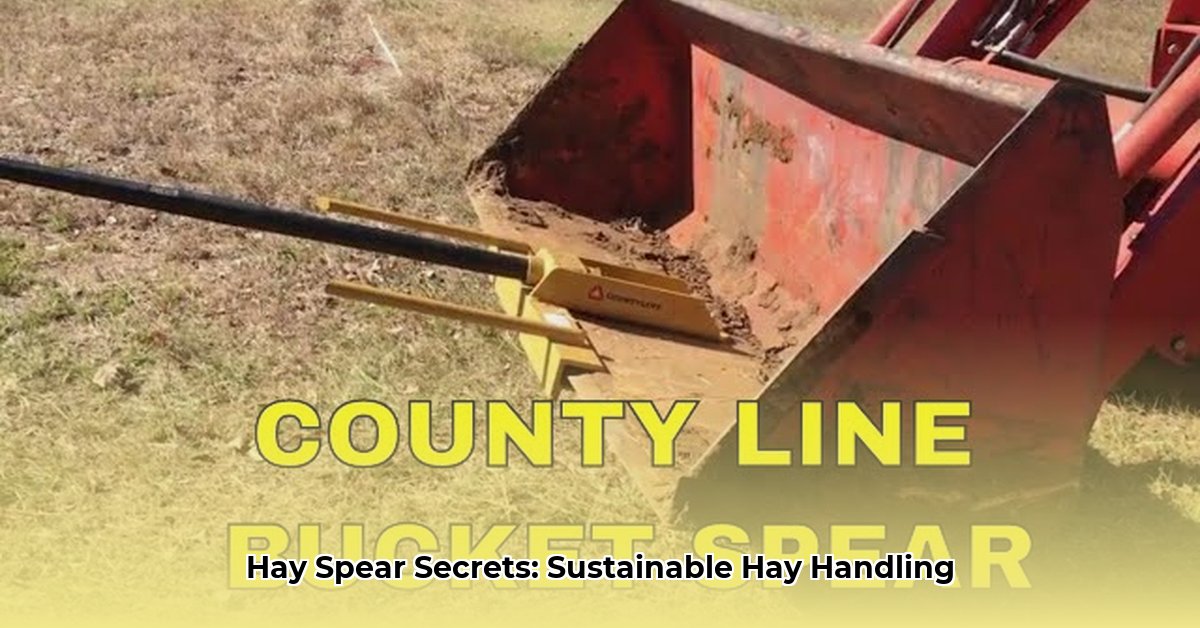
Selecting Your Perfect Hay Spear at Tractor Supply
Choosing the right hay spear is crucial for efficient and safe hay handling. Factors to consider include farm size, bale type (round or square), and bale weight. A small farm with few acres and smaller square bales will have different needs than a large-scale operation handling massive round bales. Tractor Supply offers various spears; consult their staff for personalized recommendations. Examine specifications like weight capacity and build quality. A durable spear minimizes replacements, reducing waste and promoting sustainability. Remember that a higher initial investment in a quality spear often translates to long-term cost savings and reduced environmental impact. For more information on hay spears, check out Tractor Supply Hay Spears.
Mastering Safe Hay Spear Operation
Safety is paramount. Before operation, inspect the spear for damage (loose bolts, cracks). Ensure secure attachment to your tractor. Operate at a steady speed, avoiding sudden movements or jolts. Always be aware of your surroundings – watch for obstacles, equipment, and people. Never attempt repairs while the spear is attached to the tractor. Following manufacturer instructions is crucial for safe operation and minimizing risk. Remember, safe practices ensure both your safety and the longevity of your equipment, ultimately reducing waste.
Maintaining Your Hay Spear for Long-Term Performance
Preventative maintenance is key to a long-lasting, efficient hay spear. After each use, thoroughly clean the spear, removing mud and debris. Weekly lubrication of moving parts prevents rust and ensures smooth operation. A monthly inspection checks for wear, loose bolts, or damage. Repair or replace worn parts immediately to prevent further issues. This proactive approach extends the spear's lifespan, reducing waste from premature replacements and contributing to sustainable farming practices. A well-maintained spear represents a significant return on investment both financially and environmentally.
Sustainable Hay Handling: The Environmental Benefits
Efficient hay handling directly contributes to sustainable agriculture. Less wasted time and effort translate to lower fuel consumption and reduced greenhouse gas emissions. Minimizing hay damage saves resources and reduces waste. Choosing durable materials, such as high-strength steel spears from Tractor Supply, further minimizes the environmental impact by reducing the need for frequent replacements. By prioritizing efficient and safe practices, you can significantly lower your farm's carbon footprint.
Comparing Hay Spear Options (Hypothetical Examples)
The following table presents hypothetical comparisons. Consult actual product specifications for accurate details.
| Feature | Spear X | Spear Y | Spear Z |
|---|---|---|---|
| Bale Capacity | 1-2 Large Round Bales | Up to 4 Medium Round Bales | 2-3 Large Square Bales |
| Material | Heavy-duty Steel | Steel with Protective Coating | High-Tensile Steel |
| Weight | 175 lbs | 225 lbs | 200 lbs |
| Estimated Lifespan (Years) | 6-8 | 8-10 | 10+ |
| Estimated Price Range | $250-$350 | $400-$500 | $450-$600 |
How to Reduce Environmental Impact of Hay Bale Handling
Efficient hay handling minimizes waste, lowering fuel consumption and greenhouse gas emissions. Proper spear selection and usage reduce hay spoilage. Strategic feeding minimizes waste and improves nutrient cycling. Regular maintenance extends spear lifespan, reducing waste from premature replacement. These practices collectively enhance environmental sustainability and operational efficiency.
Choosing the Right Hay Spear for Sustainable Practices
Consider farm size and bale type to maximize efficiency and minimize fuel use. A durable spear reduces the need for replacements. Careful consideration of a spear's longevity will contribute significantly to long-term sustainability.
Safe and Efficient Spear Operation: A Step-by-Step Guide
- Pre-operation Checklist: Inspect for damage; secure all components.
- Picking Up Bales: Approach slowly and carefully; center the spear accurately.
- Transporting Bales: Drive carefully and smoothly to minimize bale loss.
- Placement and Unloading: Position the spear precisely for easy unloading.
- Post-Operation Maintenance: Clean and lubricate the spear.
Minimizing Waste Through Proper Hay Handling
Strategic feeding, proper storage, and pasture management contribute to minimizing hay waste and spoilage, which in turn positively affect environmental sustainability.
Maintenance for Longevity and Sustainability
Regular lubrication and inspection help maximize the lifespan of your hay spear, thus reducing the environmental impact of frequent replacements. Promptly addressing minor repairs prevents larger problems. A well-maintained spear reduces waste and contributes to a sustainable farm.